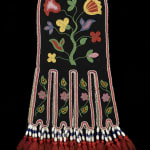UNIDENTIFIED MAKER, PROBABLY MÉTIS OR DENE (ATHABASKAN / ATHAPASKAN)
decorated to both sides with intricate floral designs;
contained in a custom made acrylic and canvas display;
with affixed paper label, "Pres'd by / Mr. J. Summer Marriner / 1913".
LOT 28
ESTIMATE: $12,000 — $18,000
PRICE REALIZED: $12,000.00
It is thought that this extraordinary type of bag may have had its origins among decorated animal skin bags (incorporating their legs and tails) made by Ojibwa artists in the Great Lakes region during the eighteenth century. Used also among the Salteaux of Manitoba, the design of these pouches eventually took on their present design, perhaps with the animals’ four legs morphing into more stylized pendant shapes [1]. The Métis used the bags as firebags (see Lot 66 for a gorgeous and perhaps related form of bag), decorated them with floral designs taught at mission schools, and through brisk trade rapidly spread the bags themselves and their design northwest into Athapaskan and Tlingit territories by the 1850s. Octopus bags were soon made and traded by Athapaskans and Tlingit themselves; it may have been the Tlingit who popularized the term “octopus bag” because of their distinctive shape, with four appendages each ending in two points (for a total of eight points). The term is now in wide use.
The Plains Métis were not only the great popularizers of octopus bags, they were also by far their most prolific makers. This spectacular example follows Métis design principles to a great degree. Métis floral patterns were quite free-form and relatively asymmetrical, and followed Ojibwe patterns by incorporating differing plant elements (the “four states of vegetation”) [2]. Tlingit designs were much more symmetrical; in addition, Tlingit artists did not decorate both sides of their bags. Which brings us to an important feature of this example: it is fully - and very differently - ornamented on both sides (possibly sewn by two different artists?). Both the black and red backgrounds set off the gorgeous floral designs - tightly sewn with tiny beads - beautifully. Lovely trim and a handsome fringe compliment the “octopi” splendidly.
1. See Lawrence J. Barkwell, “Metis Octopus Bags”, www.metismuseum.ca/media/db/11910.
2. Ibid.
References: For a discussion of octopus bags as well as illustrations (including documentary) see Kate C. Duncan, Northern Athapaskan Art: A Beadwork Tradition, (Seattle: University of Washington Press, 1989), p. 180-184. See also Henry B. Collins et. al., The Far North: 2000 Years of American Eskimo and Indian Art, (Bloomington: Indiana University Press, 1977), cats. 203,204; and Bill Holm, The Box of Daylight: Northwest Coast Indian Art, (Seattle: Seattle Art Museum and Univ. of Washington Press, 1983), cats. 93-95 (Tlingit). See also Douglas C. Ewing, Pleasing the Spirits: A Catalogue of a Collection of American Indian Art, (New York: Ghylen Press, 1982), cats. 258-259.
Provenance
Donald Ellis Gallery, Toronto;Acquired from the Above by the present Private Collection, Toronto, 1990.
Join our mailing list
* denotes required fields
We will process the personal data you have supplied in accordance with our privacy policy (available on request). You can unsubscribe or change your preferences at any time by clicking the link in our emails.




